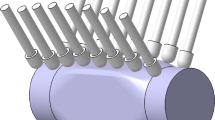Abstract
In recent years, several research works have been performed on the application of reconfigurable discrete dies (RDD) for forming sheet metals. Due to the rapid changing of these dies, they attracted the attention of flexible manufacturing systems. Meanwhile, only flat sheet metals were examined, and no research work has been reported on the application of the mentioned dies for tubular parts. In this paper, a new RDD for spinning tubular parts were designed and fabricated. The results obtained in this research illustrated that hollow axisymmetric parts could be produced using this type of die, and that this technique leads to the production of tubular parts with desired accuracy and quality. The strain distribution diagrams of formed samples showed that the length of samples decreases and the wall thickness of them increases after forming. Increase in wall thickness in the middle of the tube is more than the sides and decrease in length in the sides is more than the middle. The twisting deformation increases as the depth of forming area increases. The dimension accuracy of formed samples is acceptable by taking into consideration the likely errors.
Similar content being viewed by others
References
Walczyk DF, Hardt DE (1998) Design and analysis of reconfigurable discrete dies for sheet metal forming. J Manuf Syst 17(6):436–454
Walczyk DF, Lakshmikanthan J, Kirk D (1998) Development of a reconfigurable tool for forming aircraft body panels. J Manuf Syst 17(4):287–296
Walczyk DF, Hardt DE (1999) A comparison of rapid fabrication methods for sheet metal forming dies. J Manuf Sci Eng 121:214–224
Olsen BA (1980) Die forming of sheet metal using discrete surface, M.S Thesis. MIT, Cambridge
Hardt DE, Olsen BA, Allison BT, Pasch K (1981) Sheet metal forming with discrete die surfaces. Proc Ninth N Am Manuf Res Conf 140–144
Papazian JM, Anagnostou EL, Christ JR, Hoitsma D, Ogilvie P, Schwarz R (2002) Tooling for rapid sheet metal parts production. 6th Joint FAA/DoD/NASA Conf. on Aging Aircraft, San Francisco, CA, USA, September 16–19
Owodunni O, Diaz-Rozo J, Hinduja S (2004) Development and evaluation of a low-cost computer controlled reconfigurable rapid tool. Comput Aided Des Appl 1(1–4):101–108
Yao J, Murata M (2002) Effects of indented feed of roller tool on parallel spinning of circular aluminum tube. J Mater Process Technol 128:274–279
Yao J, Murata M (2002) An experimental study on paraxial spinning of one tube end. J Mater Process Technol 128:324–329
Yao J, Murata M (2005) An experimental study on spinning of taper shape on tube end. J Mater Process Technol 166:405–410
Murata M, Kuboki T, Murai T (2005) Compression spinning of circular magnesium tube using heated roller tool. J Mater Process Technol 162–163:540–545
Author information
Authors and Affiliations
Corresponding author
Rights and permissions
About this article
Cite this article
Amini, M., Bakhshi, M. & Fesharaki, J.J. Design, fabrication, and use of a new reconfigurable discrete die for forming tubular parts. Int J Adv Manuf Technol 75, 1055–1063 (2014). https://doi.org/10.1007/s00170-014-6207-7
Received:
Accepted:
Published:
Issue Date:
DOI: https://doi.org/10.1007/s00170-014-6207-7




